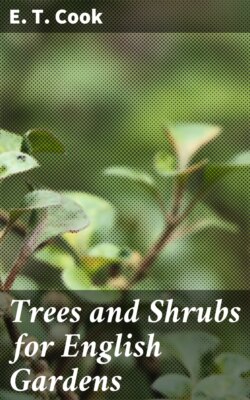Читать книгу Trees and Shrubs for English Gardens - E. T. Cook - Страница 3
На сайте Литреса книга снята с продажи.
ОглавлениеPREFACE TO FIRST EDITION
Table of Contents
It cannot be urged against this work that it travels along a path already well worn, for the subject of trees and shrubs for English gardens, though almost inexhaustible, has never been so fully treated and illustrated as it deserves. The book may have many defects, but its pages will show that an honest effort has been made to offer helpful and instructive information to the many who wish to know more of the beauty of trees and shrubs.
In writing this book, the labour of my spare hours for many months, I have been greatly helped by Mr. Bean, the assistant-curator of the Royal Gardens, Kew, whose deep knowledge of the subject has been willingly imparted; and by Miss Jekyll, to whom I am indebted for many valuable suggestions and notes. Among others to whom grateful thanks are tendered are Mrs. Davidson, Mr. J. Clark, Mr. Dallimore, and Mr. S. W. Fitzherbert.
Some of the chapters have already appeared in the Garden, with the object of making known as widely as possible the importance of the most beautiful trees and shrubs for English woodland and pleasure-grounds.
The illustrations will show how a shrub, so often stunted and mutilated by unwise pruning, becomes beautiful when allowed to develop naturally.
The illustrations have their own teaching value, and in this matter also I desire to thank many willing helpers, especially Miss Jekyll, Miss Willmott, and Mr. Crump, of the Madresfield Court Gardens. Many of them are from photographs taken in the Royal Gardens, Kew. Under the present director (Sir William Thiselton-Dyer) much has been done in the judicious grouping of plants. Here is a living place of instruction open to all.
Those who desire to know more about trees and shrubs than it is possible to give in this book should consult such famous works as Loudon's "Arboretum Britannicum" (8 vols.), and "Encyclopædia of Trees and Shrubs"; Professor Sargent's "Silva of North America," and "Forest Flora of Japan"; "Manual of Coniferæ," by Messrs. James Veitch & Sons; "The Pinetum," by George Gordon; The "Bamboo Garden," by Lord Redesdale; Sir Joseph Hooker's "Rhododendrons of the Sikkim Himalaya"; and the excellent Kew Hand-list of Trees and Shrubs. Much information can also be gleaned from the volumes of Garden and Forest (American), edited by Professor Sargent, but not now in publication.
The nomenclature at Kew—that is, according to the Index Kewensis—is that adopted in this book.
It is the wish and hope of the author, whose notes, taken during many years, are embodied, that the book may do something to make English gardens more beautiful and interesting, and that it may win many to see the better ways of planting; also that it may be the means of bringing forward the many trees and shrubs of rare charm that are generally unknown or unheeded.
E. T. C.
November 1902.
PREFACE TO SECOND EDITION
Table of Contents
This edition has been thoroughly revised to render it as useful as possible to those who desire a larger acquaintance with the many beautiful trees and shrubs that are hardy in this country. I must tender my heartiest thanks to Mr. William Atkinson (Messrs. Fisher, Son, & Sibray) for his valuable help in preparing this edition. Many of the illustrations represent trees and shrubs in the Royal Gardens, Kew, which are not only beautiful in themselves, but are the centre of scientific research.
E. T. C.
March 1908.
TREES AND SHRUBS
Table of Contents
CHAPTER I
Table of Contents
WANT OF VARIETY A BLEMISH
Table of Contents
There is a sad want of variety amongst evergreen and deciduous shrubs in the average English garden. Faith is placed in a few shrubs with a reputation for robbing the soil of its goodness and making a monotonous ugly green bank, neither pleasant to look at nor of any protective value. As one who knows shrubs well and the way to group them says, "Even the landscape gardeners, the men who have the making of gardens—with, of course, notable exceptions—do not seem to know the rich storehouse to draw from." Very true is this. We see evidence of it every day. The mixed shrubbery is fondly clung to as a place for all shrubs, whether flowering or otherwise, and the result is a thicket of growths, a case indeed of a survival of the fittest. There are other shrubs than Privet in this fair world of ours, and as for providing shelter, the wind whistles through its bare stems and creates a draught good for neither man, beast, nor plant. Of the cherry laurel again there is far too much in gardens. Few other plants can stand against its greedy, searching roots, and its vigorous branches and big leaves kill other leaf-growth near them. Grown in the proper way, that is, as an isolated shrub, with abundance of space to develop its graceful branches and brilliant green leaves, the Cherry Laurel is a beautiful evergreen; it is quite happy in shady, half-wooded places. But grown, as it is so often, jammed up and smothering other things, or held in bounds by a merciless and beauty-destroying knife, its presence has not been to the advantage of English gardening.
When the planting season comes round, think of some of the good shrubs not yet in the garden, and forget pontic Rhododendron, Laurel, Aucuba, and Privet. By this is not meant rare shrubs, such as may only be had from the few nurseries of the very highest rank or from those that make rare shrubs a speciality, but good things that may be grown in any garden and that appear in all good shrub catalogues.
